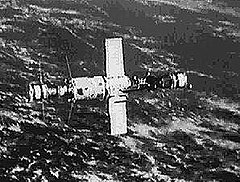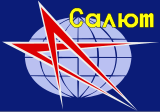
Back ساليوت 6 Arabic Салют-6 Bulgarian Saliut 6 Catalan Saljut 6 Czech Saljut 6 German Saliut 6 Spanish Saljut 6 Finnish Saliout 6 French Saliut 6 Galician סאליוט 6 HE
 | |
 Salyut programme logo | |
| Station statistics | |
|---|---|
| COSPAR ID | 1977-097A |
| SATCAT no. | 10382 |
| Call sign | Salyut 6 |
| Crew | 3 |
| Launch | 29 September 1977, 06:50:00 UTC |
| Launch pad | Baikonur, Site 81/24 |
| Reentry | 29 July 1982 |
| Mass | 19,824 kg (43,704 lb) |
| Length | 15.8 m (52 ft) |
| Diameter | 4.15 m (13.6 ft) |
| Pressurised volume | 90 m3 (3,200 cu ft) |
| Periapsis altitude | 219 km (136 mi) |
| Apoapsis altitude | 275 km (171 mi) |
| Orbital inclination | 51.66° |
| Orbital period | 89.1 minutes |
| Orbits per day | 16.16 |
| Days in orbit | 1,764 |
| Days occupied | 683 |
| No. of orbits | 28,024 |
| Distance travelled | ~1,136,861,930 km (706,413,250 mi) |
| Statistics as of deorbit on 29 July 1982 References:[1][2] | |
| Configuration | |
 Basic orbital configuration of Salyut 6 | |
Salyut 6 (Russian: Салют 6, lit. 'Salute 6') was a Soviet orbital space station, the eighth station of the Salyut programme, and alternatively known DOS-5 as it was the fifth of the Durable Orbital Station series of civilian space stations. It was launched on 29 September 1977 by a Proton rocket. Salyut 6 was the first space station to receive large numbers of crewed and uncrewed spacecraft for human habitation, crew transfer, international participation and resupply, establishing precedents for station life and operations which were enhanced on Mir and the International Space Station.
Salyut 6 was the first "second generation" space station, representing a major breakthrough in capabilities and operational success. In addition to a new propulsion system and its primary scientific instrument—the BST-1M multispectral telescope—the station had two docking ports, allowing two craft to visit simultaneously. This feature made it possible for humans to remain aboard for several months.[3] Six long-term resident crews were supported by ten short-term visiting crews who typically arrived in newer Soyuz craft and departed in older craft, leaving the newer craft available to the resident crew as a return vehicle, thereby extending the resident crew's stay past the design life of the Soyuz. Short-term visiting crews routinely included international cosmonauts from Warsaw pact countries participating in the Soviet Union's Intercosmos programme. These cosmonauts were the first spacefarers from countries other than the Soviet Union or the United States. Salyut 6 was visited and resupplied by twelve uncrewed Progress spacecraft including Progress 1, the first instance of the series. Additionally, Salyut 6 was visited by the first instances of the new Soyuz-T spacecraft.
The success of Salyut 6 contrasted with the programme's earlier failures and limited successes. The early history of the programme was plagued by the fatalities of Soyuz 11 and three launched stations which quickly failed. Earlier successful stations received few crews, limited to several weeks' habitation by the design life of their Soyuz craft and the presence of a single docking port per station; unsuccessful docking was also common. Salyut 6 on the other hand routinely received successful dockings of crewed and uncrewed craft, although the first visiting craft Soyuz 25 and later Soyuz 33 failed to dock with the station.
From 1977 to 1981, the station was occupied by human crews during six separate, discontinuous intervals, each coterminous with the presence of a resident crew who were first-in, last-out while support crew visited. Between each of these intervals Salyut 6 was vacant, although it was visited by Soyuz T-1 and Kosmos 1267 during its periods of vacancy. Following the launch of successor Salyut 7, Salyut 6 was de-orbited on 29 July 1982, almost five years after its own launch.[1][4]
- ^ a b Cite error: The named reference
SSSMwas invoked but never defined (see the help page). - ^ Cite error: The named reference
nssdc1was invoked but never defined (see the help page). - ^ Cite error: The named reference
Chiarawas invoked but never defined (see the help page). - ^ Cite error: The named reference
bakerwas invoked but never defined (see the help page).